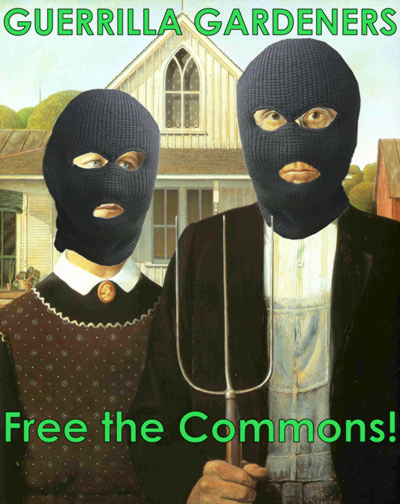Guerrilla Gardening is, if you’ll forgive the pun, gaining ground. The term and practice of planting gardens on empty or underutilized land is becoming more popular. The current economy has left large plots of arrable land vacant and unused as foreclosures, bankruptsies, and other financial and legal maneuverings leave the status of the real estate in question. Intrepid, green-thumbed adventurers are stepping in to improve and beautify their communities, and raise food for the needy on a clandestine basis.
Guerrilla gardening has been on my mind a lot lately for a couple of reasons. It’s making the national news, for one thing. Our own efforts here on the “homestead” sometimes seem like guerrilla warfare for other reasons than land rights and ownership issues. Mainly, though, my brother, Dave, has turned my thoughts to the topic. He brought it up on his excellent blog, Triloboats. His interview with our mutual friend, James David Sneed, on the subject is enlightening on a couple of different levels. In conjunction with the interview, Dave created the great graphic above, and asked me to make it available on T-shirts and other gear on our online store, which I’ve recently done.
As I’m fond of pointing out, things are different here in Alaska, and Dave and James David’s discussion of guerrilla gardening in Southeast Alaska differs from the challenges of urban guerrilla gardeners down south. Dave and I have long discussed the idea of small, secluded plantings throughout the region that can provide fresh vegetables while living aboard sailboats, as Dave and his wife, Anke, do, and as we planned to do before moving to the “homestead.”
Augmenting our own efforts to plant small, wild gardens would be the many former gardens around Southeast that have gone feral over time. James David mentions one of these instances in the interview; there are many more. Ghost towns and mining camps from the Gold Rush Era, abandoned homesteads and fish camps, and old fur farms dot the region. Most of the archipelago’s small islands have been used at one time or other to raise furbearing animals, largely mink and fox. Operators would set up a wild population, more or less restricted to the island by surrounding ocean, and trap what they needed to sell. Often they would live on the islands themselves, which almost always meant growing a kitchen garden.
Many of these formerly “tame” gardens continue to propagate long after being abandoned. For years, we grew walking onions from starts someone gathered at Stan and Esther Price’s Pack Creek homestead on Admirality Island. I foraged in the garden myself one summer when I helped lead a small group of Boy Scouts on a kayaking expedition to the creek to view the brown bears that gather there for the salmon runs. When one knows one’s garden plants, it’s easy to find them growing among the natural foliage in unexpected places. In many cases their presence is the only recognizable trace of previous human habitation.
Michelle and I often discussed branching out beyond knowing good local places to forage wild plants to augment our own garden. We even got permission to plant a neighbor’s garden plot while they are living “outside.” So far, the needs of our own garden have kept us fully occupied. Besides, as a neighbor recently commented, there’s something special about tilling one’s own soil. It’s the best way to go, when one can, but I continue to root for the guerrillas.

Hi,
I guerilla garden in Virginia. When the state puts in a new off/on ramp, I bomb it with seed balls, just to make it a little nicer looking for people on their way to and from wherever. The state just puts down contractors grass and hay. They let nature do the rest, but it takes nature a while to repair the damage to a hillside. I also bomb construction sites. This used to not be an issue, but with the economy, we have several places that were cleared, and even had storm drains put in, but they have sat for a few years untouched, and become an eyesore. Anyway, the reason I am writing is to tell you what I have done recently. I sent 50 seed balls, which contain native flower seeds and two to three black oil sunflower seeds each, in a flat rate ($5.35) postal box, and $10 to an organization called Ransomed Heart in Colorado Springs. I did this because I remember seeing Mt. St. Helens 2 years after the devastation, and it still looked so bleak. I thought by sending seed balls to someone in Colorado to plant in the spring, may not replace the lost homes, but may just make things look a little brighter this coming spring and summer. A little bit of color can really make a difference in such a bleak environment. I sent only drought hardy native seed, because they have the best chance of survival and should not be invasive. I included the black oil sunflower seed, so it would grow into a food source for birds and small animals. Squirrels, chipmunks, and other animals may take and bury the seed balls as food for next winter, but that is fine, because it will increase the seed balls chance of success and disperse the seed balls over a wider range. So, if you know a person or organization in the Colorado Springs area, then send them some seed balls and maybe a few bucks. They may not need the money, but I am sure they know someone who does.
Signed,
The Lone Granger
“Remember, if we all have a green thumb, then we will have a green planet.”
“Just plant something!”
Excellent idea, Bob! I commend you for thinking this through so carefully, i.e. ensuring that the seeds are draught-hardy and non-invasive. I hope it works!